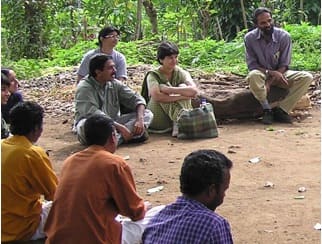
Governance institutions
One of the characterizing features of ICCAs—territories of life is the presence of functioning governance institutions able to make and enforce decisions and rules about access to the territory and use of its natural resources. Local institutions in charge of ICCAs—territories of life are very diverse, ranging from councils of elders to elective committees and village assemblies, from traditional to modern institutions or combination thereof, from small informal user groups born to care for a single specific resource to organisations with formal headquarters, large staff and multimillion dollar annual budgets. Governing institutions are part of the biocultural heritage of any community and, when well-functioning, promote the conservation and sustainable use of its life environment. Without a functioning governance institution, the sustainable use of local natural resources would often not be possible, as there would be no collective body capable of expressing and implementing the shared desires, needs, concerns and interests of the community.
Local governance institutions may or may not be officially recognized by the state (or states) where the ICCA—territory of life is placed; they may find themselves overpowered by other governance institutions (including because of action by police and the military); or they may work in collaboration with them. For a well-functioning ICCA—territory of life, external recognition can be important. Nothing, however, is possibly more important than a governing institution that is fully self-recognised, i.e. perceived as legitimate by its relevant community/people. Such an institution is likely to exhibit governance vitality (see #Governance) and be an integral part of the shared identity of the community.
Should ICCAs—territories of life fear the ‘tragedy of the commons’?
Indigenous peoples and local communities generally hold the land, water and natural resources in their territories of life as commons, under a collective governance institution. In 1968, Garret Hardin made commons (in)famous by linking them to what he called the ‘tragedy of the commons’. According to him, natural resources managed as commons – or common pool resources – were doomed to be overexploited and exhausted by the members of their own communities because of a combination of individual greed and free-rider’ attitudes. His theory and the remedies he suggested – transforming commons into private property or state-controlled systems – were extensively used to justify the eviction of indigenous peoples and local communities from their lands to create privately owned parcels or government holdings for both productive use and conservation purposes.
Hardin’s case was based upon a-historical, self-serving and politically-driven limitations. His assumption was that commoners cannot talk or achieve agreements and that they are unable to implement rules or demand fines from violators. In fact, Hardin’s so-called ‘commons’ were deprived of what makes the commons meaningful, i.e. the social bonds that create governing institutions and agreed rules. His ‘commons’ were a strawman, a caricature, a criminally sour account that owed its fortune to a memorable title and generated untold misunderstanding and misery.[1]
In the 1990s, the work of Elinor Ostrom showed that Hardin’s analysis was not only inaccurate, but utterly mistaken.[2] She paved the way to the recognition of the governance institutions of real ‘commons’, where local communities and indigenous peoples are not doomed to devastate natural resources but, on the contrary, can use them sustainably and conserve them through time.
Through the study of the relationship between indigenous peoples and local communities and their commons around the world (nowhere featured in Hardin’s paper), Ostrom identified the conditions (or principles) that allow governance institutions to rule long-surviving resource pools: clearly defined boundaries; rules adapted to local conditions that allocate resources to users; resource-users participation in the decision-making processes; external authorities recognition of rules; accountability of the users; systems of graduated sanctions; local and low-cost conflict-resolutions mechanisms; and long-term #tenure rights. These conditions encompass what many Members of the ICCA Consortium aim at achieving or maintaining to promote the good functioning of ICCAs—territories of life.
Key references:
Hardin, 1968; Ostrom, 1990; Becker and Ostrom, 1995; McCay and Acheson, 1997; Ostrom, 2005; Kothari et al., 2012; Borrini-Feyerabend and Hill, 2015; Farvar et al., 2018.
[1] Significantly, Hardin was also a white nationalist, considered as “one of the intellectual pillars of modern scientific racism”, with a mission of “transforming environmentalism into a weapon to use against immigrants, minorities and poor nations.” See: https://www.splcenter.org/fighting-hate/extremist-files/individual/garrett-hardin
[2] Others also discussed this, in particular McCay and Acheson, 1987.